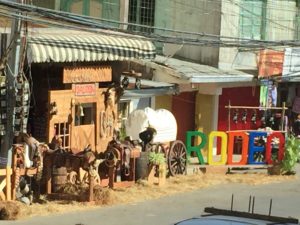 When I hear the word rodeo, I immediately think of Texas. Mike, my late husband, hailed from Texas, and we had a chance to see a rodeo several years back. When Maloli Espinosa-Supnet invited me to the Rodeo Masbateño, I readily agreed, curious to learn about the Filipino version of this Texan tradition. Little did I know that I was in for an exciting experience.
When I hear the word rodeo, I immediately think of Texas. Mike, my late husband, hailed from Texas, and we had a chance to see a rodeo several years back. When Maloli Espinosa-Supnet invited me to the Rodeo Masbateño, I readily agreed, curious to learn about the Filipino version of this Texan tradition. Little did I know that I was in for an exciting experience.
My flight was to leave at 5:00 am Tuesday, which meant I had to be up by 2:30 am to get dressed for the airport. And since I finished packing at 1:00 am, I literally had just an hour’s wink before my fellow-traveler Andrè Kahn picked me up with cowboys hats in tow. Having served for several decades on the Advertising Board of the Philippines and the Kapisanan ng mga Brodkaster ng Pilipinas in different capacities as chairman, vice-chairman, president and director, Andrè was close to Maloli who owned The Ranch 95.9, the Sound of Masbate.
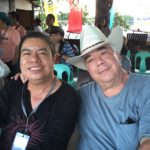
With us on the plane ride to Masbate was another industry friend of Andrè’s, Boy Pangilinan. A major sponsor of the Rodeo, BoyP took care of marketing and promotions for the event. Listening to him talk passionately about the Rodeo, I could see his eyes light up. Here was a man who loved Masbate and its Rodeo, despite the fact that he is not from there. An independent media buyer/planner, BoyP has a travel blog called boyplakwatsa.com. BoyP’s passion is to travel to all the islands of the Philippines, even to the remotest barrios, and share the beauty of the country in his blog. Needless to say, boyplakwatsa.com is quite popular with nigh over 48,000 followers.
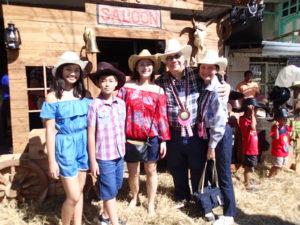
Arriving at the airport, we were greeted by a group of cowboys and cowgirls line dancing at the arrival area. Waiting outside was Maloli who quickly whisked us to her home for breakfast and to get dressed for the rodeo opening and the grand parade. There I met Maloli’s husband, General Mark Supnet, her brother Mark and his lovely wife Gidget Cabreza-Espinosa and their two younger children, Lian and Marcus. We hied off to witness the Grand Rodeo Festival Parade.
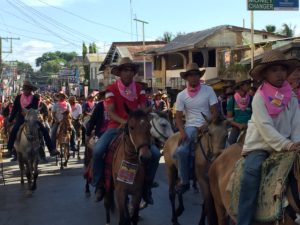
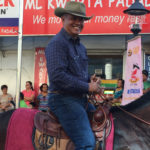
Watching the parade, my excitement mounted as ranch owners, cowboys and cowgirls rode by on horses, followed by representatives from various organizations, all dressed to the nines in western attire. I noticed that many of the cowboys rode the horses confidently, using only blankets to cushion the ride. Mark Supnet and Mark Espinosa rode by on huge, stately horses.
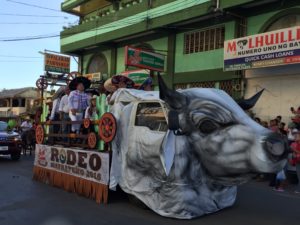
Maloli, being part of the
festival organizers, Rodeo Masbateno, Inc. (RMI) rode with the other board members on a float designed like a bull. They were all wearing colorful Mexican hats.
There were cowboys displaying their prowess in whiplashing and lassoing, pretty ladies marching down the street, and smartly-dressed drum and bugle bands playing behind them. Storefronts along the main street were decorated in theme with the rodeo.
The day before the trip, Andrè had told me casually that we were guests of honor, and that we had to make a speech. I thought he was pulling my leg, but when I saw the empty chairs on the grandstand with our names on them as guests-of-honor, my heart sank. A speech without sleep? Are you kidding? What do I say?
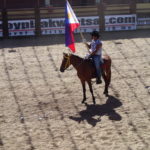
A cowboy on a horse bearing the Philippine flag signalled the singing of the Philippine national anthem. The organizers gave each of the VIP guests a pigeon to hold and release at the same time together with 100 other pigeons. Anxiety mounted as the person handing the pigeons got closer to me. Being deathly afraid of all feathered birds as a result of a childhood trauma, I whispered frantically to Andrè that I just couldn’t do it. He said it was OK and handed me the camera to document the release. It was a magnificent sight to behold.
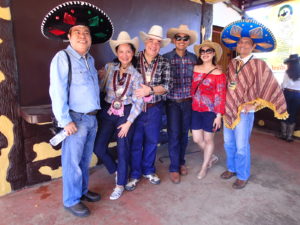
We shared the VIP seats with the Rodeo Masbateño Inc. President Judge Manuel Sese; local government officials: the governor, his wife the vice-governor, the city mayor; two congresswomen; and three senatorial candidates: Roman Romulo, Rissa Hontiveros and Sherwin Gatchalian. Even Korina Sanchez-Roxas, wife of Liberal Party Standard bearer Mar Roxas, showed up. Evidently it was campaign season. I admired the organizers when I learned they had limited the politicians’ speeches to a minute each. The rodeo festival was not meant to be a political rally, they stressed.
True enough, I was called to the podium to give a speech, and I decided to focus on the benefits tourism can bring to Masbate especially with regard to job creation and inclusive growth. I urged Masbateños to promote not just the Rodeo but the province’s other attractions like its marine sanctuaries and beautiful beaches, cautioned them to take care of the environment to ensure sustainability, and invited everyone to become ambassadors and promote the province by posting positive news daily about the Masbate on their social media networks like Facebook, Instagram and Twitter.
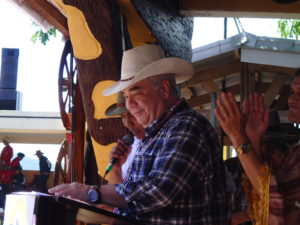
Up next was Andrè, and he congratulated the organizers on placing the Masbate Rodeo Festival not just on the Philippine map but on the international map of rodeos. When Andrè said that the Masbate Annual Rodeo has become as popular as the Sinulog of Cebu, the Maskara of Bacolod, and the Panagbenga of Baguio, the crowd cheered. Since Andrè had been visiting Masbate since the early 90s when there were still no hotels, he spoke from the heart when he observed that indeed Masbate has changed and that the Rodeo has branded Masbate as the cattle capital of the country. Strong words from a pillar of the advertising broadcasting industry!
The competing teams hailing from all over the Philippines were then called in and took their oath of sportsmanship. The teams consisted of professionals and vet med students who would compete in eight main events: cattle lassoing wrestling on foot, steer lassoing on horseback, steer wrestling from horseback, casting down, two-person carambola, four-person carambola, bull riding, and load carrying. It was interesting to note that teams included women. Inclusiveness and diversity was in force. Other events included bull riding for women, team penning and bronco riding.
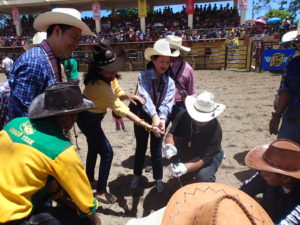
The opening ceremonies ended with the ceremonial branding of the rodeo bull. Praying that it would not be too painful for the bull, Rissa Hontiveros and I held the branding rod and pressed it in the bull’s haunch. It was Andrè’s turn next to brand the bull.
I learned that the Rodeo Festival upholds Republic Act 8485 or the Animal Welfare Act of 1998, which calls for the safety of animals. There is even a resident certified rodeo veterinarian, Hernando Durongon who looks after the safety of the participating animals. Participating cattle are lent by ranch owners and RMI is responsible for their well being during the festival.
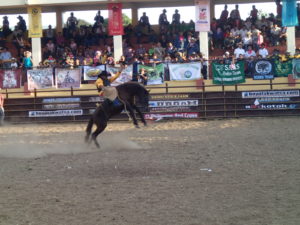
Later that day, we were lucky to watch the rodeo from the media bleachers where we were closer to the action. There were bronco rides where the rider had to stay eight seconds on the horse, waving his hand without touching his head. There was a team competition where cowboys on foot had to lasso a bull and bring it to the
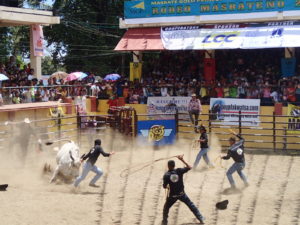
ground, then tie up its legs. And another where cowboys on horseback had to do the same. There were heart thumping moments when the bulls were huge and mean, and the cowboys fell and were seemingly trampled or kicked by the bull. And other funny moments when the bull refused to play and just lay down by itself, prompting the cowboys to coax it up.
Wednesday at 9am was the cattle run. We went to the starting point in the midst of town where about 30 heads of cattle would be released with cowboys herding them. The streets were packed with Masbateños eager to watch the run. I asked if there was any risk to the spectators seeing how some of the bulls yesterday were pretty mad and charged the cowboys. The organizers told us the cowboys would make sure we were unharmed. Nevertheless, we marked a quick getaway path just in case a rogue bull went berserk. It was so exciting I forgot to take a picture of their release, intent on saving my hide. What a coward I was!
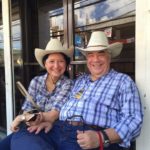
We moved to another location for the second release where over a 100 heads of cattle would be released. This time, however, we were safely behind an elevated and grilled veranda with the doctors from the Department of Health. Best company to be with. Maloli, on the other hand, proved to be the real cowgirl as she clambered fearlessly over an open pick-up to better see the cattle run.
The Filipino sense of humor spilled out as people awaited the arrival of the cattle. Here was a cowboy galloping down the street as if a whole tribe of Indians were after him. There was another elderly man, possibly in his 80s, doing cartwheels on the street. Another cowhand sat on his haunches, rolling his lasso. We, on the other hand, took selfies with the doctors, another Filipino tradition.
And then the cattle arrived with cowboys. What a sight to behold! I felt like I was in a Western movie, except this was the real thing. The cattle run was over in a matter of minutes, but not before some decided to make a detour and enter the side streets, with the cowhands running after them to herd them back out into the street. We were laughing as they were brought back out. In one case, the cowhand came out riding the bull, drawing laughter from the crowd. Maloli recounted how in one instance a bull entered a BIR office and refused to leave. It probably wanted to see Henares!
After the cattle run, we proceeded to the rodeo arena where the cattle were kept for the herding competition. It was interesting how there seemed to be leaders in the pack. When they moved, the rest followed. Most of the cattle stayed together as a herd, but there were one or two loners that stayed apart, and another lazy one that refused to stay under the sun, and kept close to the shaded area. Could be a senior citizen, we surmised.
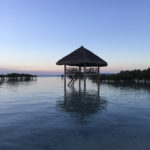
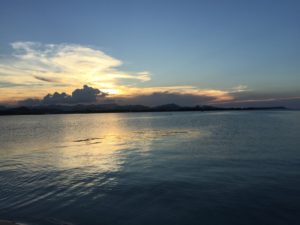 Late afternoon, we decided to take a break from the rodeo and go swimming. Mark and Gidget brought us to Buntod Marine Sanctuary. Buntod is actually a powdery white sandbar on one end and a mangrove on the other. In the midst is a house on stilts where people could eat the picnic food they brought, and rent snorkelling and dive equipment.
Late afternoon, we decided to take a break from the rodeo and go swimming. Mark and Gidget brought us to Buntod Marine Sanctuary. Buntod is actually a powdery white sandbar on one end and a mangrove on the other. In the midst is a house on stilts where people could eat the picnic food they brought, and rent snorkelling and dive equipment.
The place was packed with people frolicking on the sandbar and swimming. Teenagers were playing patintero, fathers were teaching their young how to swim, and mothers were packing as the sun was setting soon. We noticed one mother scrubbing her caldero with sand while her little daugher watched. And because we are all Filipinos, most everyone had their mobile phones out taking photos of the fun they were having.
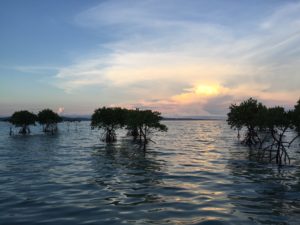
We swam in the crystal clear blue water, and walked along the mangroves. It was so peaceful by the mangroves, a popular date place for lovers according to Mark. A flock of birds flew in formation, momentarily disturbing the calm. We marvelled at the fruit of the mangrove tree, like a string bean growing out of a chico with horns, as Andrè described it.
Soon the other boats had departed and we were the only ones left. Except for the gentle lapping of the waves against the stilts, all was quiet. We feasted on turon with langka and cassava boiled in coconut milk while watching the sun set, and the colors of the sky change from blue to pink to grey. It was magical!
Thursday morning, we set off for the 500-ha ML Ranch in Punta Tigbao with Mark, Gidget and their children. ML stands for Moises and Ludivina, the parents of Mark and Maloli. Moises was the former governor of Masbate. His youngest son Mark now managed the ranch.
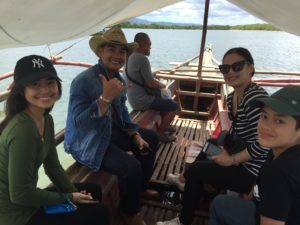
To get to Sitio Punta Tigbao, we first took a 45-minute car ride to Calasuche, then take another 45-minute boat ride on a banca with bamboo outriggers. The waters at first were calm, but became rather choppy as we went further out to sea. White caps appeared on the waves, a sure sign that the waters were rough. Pretty soon, my denim pants and rubber shoes were drenched.
Disembarking at Sitio Pinta Tigbao, we toured the 100-families strong fishing community. Mark explained that his father had allowed the community to settle there. It was a self-sustaining community, with a small chapel, an elementary school from kinder to grade six, a basketball court, and a smaller plaza. Funds came from a project called ‘Piso sa Kilo’ which the Espinosas started. For every kilo of fish caught and sold, the fishermen donated P1 to the fund.
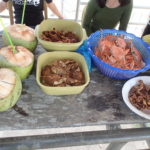
It was clear that Mark was respected and loved by the residents of the community. The men approached him for advice, guidance and orders, speaking to him in gentle voices, and the women smiled and greeted us. We walked to the fenced cattle corral and climbed the raised hut in its midst. There we enjoyed a sumptuous meal prepared by the villagers: freshly steamed crabs, stuffed crabs, crispy fried dried squid, and piping hot rice.
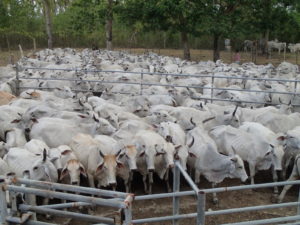
Grateful to get out of the scorching hot sun, we watched as the cattle were herded into the corral. Soon the corral was full with about 400 head of cattle. It was interesting to watch them as there appeared to be some alpha males in the group that would lead the herd. Inside the corral, two bulls challenged each other. Calves followed their moms, while their moms showed their maternal instinct as they waited to ensure their calves were following them. Mark showed us a contraption shaped like a giant inverted forked tong that would keep the cattle still while they were branded or given vitamins. There were narrow walkways between fences that would allow cattle to pass one at a time. I caught myself counting the cattle as they passed out of the corral to pasture.
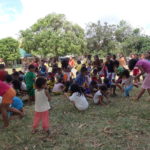
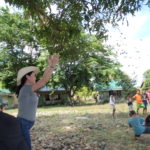
The children garbed in colorful clothes followed us, just like they did in the fairytale, the Pied Piper of Hamlyn. They climbed trees and perched on the fence, watching from a distance and waiting patiently for us to leave the cattle corral. No wonder they appeared excited as we learned that each time he visited the ranch, Mark brought candies for the children. This time around, he had a carton full of assorted colorful candies, and he kindly asked his Lian, Marcus and me to throw the the candies in the air for the children to run after. Oh, were they happy! And so were we! I made a mental note to include the 350 children in our yearend My Dream in a Shoebox campaign that provides school supplies for children in shoeboxes wrapped in festive paper.
Soon it was time to board the motorized banca and return to Masbate City. This time around, the boatride was fast and uneventful. Andrè explained that this was because we were going with the tide.
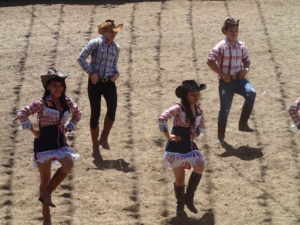
Back at the Rodeo Arena, we watched the Street Barn Dance Competition as 14 teams performed to the rolicking anthem of Rodeo Masbateño. The creativity of the teams was obvious in their costumes, props and dance moves.
We retired to the Espinosa home to have dinner with the family and pack for our early morning plane ride the next day.
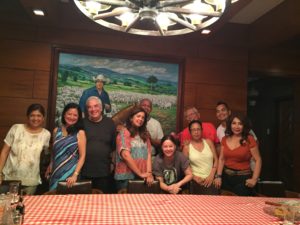
I am so grateful for the warm hospitality of the Espinosa family, especially Maloli and her husband Mark, Mark and his wife Gidget, and Carmen, Maloli’s sister-in-law who prepared a delicious sansrival for dessert. They all made our visit extra special and took such great care of us. I enjoyed the friendly family repartee during meal times, their delicious spread at the long wooden dining table, and the serious discussions as to how tourism can be developed in Masbate. I greatly admire them for the passion they have to improve the lives of Masbateños.
Looking back on the past three days, I can see clearly that Masbate has a lot of potential for tourism, especially with its beautiful beaches and its ranch life. While the Rodeo Festival brings in as many as 50,000 visitors as shared by the Department of Tourism representative I chatted with, Masbate can ensure a more sustainable tourism industry by developing more attractions. All it needs is a few enterprising people to package and promote the ranch experience and allow tourists to learn about the customs and lifestyle of ranchers, meet and talk to real-life cowboys, eat what they eat and live as they do. And while they are at it, enjoy the pristine sand and clear blue waters of Masbate, and marvel at the rich marine life it harbours in its corals. And once a year, give everyone unforgettable memories of the Wild, Wild West. I vowed to go back next year, with my children in tow, so they too can experience the unique and authentic Rodeo Masbateño.

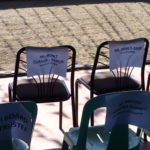
Would love to attend the 2018 Rodeo festival. How do I get in touch and with whom?
Can somebody get in touch with me pls.
Email: [email protected] or my work [email protected].
Nelida, my deepest apologies. I only just opened my blogsite after a very long time. Maloli Espinosa-Supnet was the one who invited me to the Rodeo. You may reach her at +63 917 813 2938.
Can somebody pls e-mail me back at [email protected] or [email protected].